Last Updated on 22 July 2024 by automobilehut.in
In a garage there are a lot of equipment is used to repair or rebuild a vehicle. The tools are very important for the technician for their efficient use in motor vehicles. In this article, I will discuss the 42 automotive garage tools and equipment for technicians.

Garage Tools and Equipment
Breakdown of vehicles can occur due to many reasons such as accidents, broken parts, loss of strength of component materials, etc. Such vehicles are brought to the auto garage for repair. For repairing work, some tools, machines, and equipment are required, a list of which is given here.
- Chisels
- Files
- Hacksaws
- Scrapers
- Scriber
- Try square
- Punch
- Vice
- Hammers
- Pliers
- Screwdriver
- Wrench
- Tap
- Die
- Cleaning brush
- Tools for tubes
- Tools for tires
- Feeler gauge
- Vernier Caliper
- Power tools
All of these equipment details are discussed below.
Read More- What is Oil Pressure Gauge?
#1. Chisel
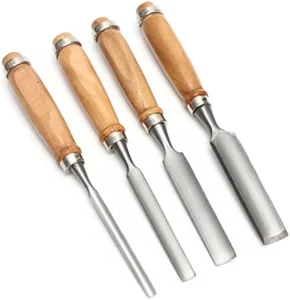
A chisel is one of the most important tools in the fitting shop. It is used for cutting and chipping the workpiece when it is cold. Chisels are made of high-carbon steel or tool steel. A chisel is in the form of a rod having a cutting edge at one end, a hexagonal or octagonal body, and a striking head at the other end. The size of a chisel is described by its length and width of edge.
When the cutting edge becomes blunt, it is again sharpened by grinding. For cutting the workpiece with the chisel, it is placed vertically on the workpiece and hammering is done upon its head. But for chipping, the chisel is inclined at 40° – 70° with the workpiece. The angle of the cutting edge of the chisel is 35° – 70° according to the metals to be cut.
Read More- Why Does Engine Knocking Occur?
#2. Files

File is one of the most important tools of the fitting shop. It is used for filing the metal surface. Files are made of high-carbon steel or tungsten steel by forging. They are hardened and tempered. The file is made of mild steel, it is case-hardened.
The advantage of such a file is that it is not brittle. Comparing the chisel and file, the chisel has only one cutting edge and requires hammering for cutting or chipping while the file has many cutting points and requires no hammering. The purpose of both tools is to cut the metal.
The size of a file is specified by its effective length, exclusive of the tang. For fine work lO to 15 cm long, for medium work 1 5 to 20 cm long, and heavy work I0 to 45 cm long files are used. For filing the workpiece in different shapes, the files are made of different cross-sections. Some of the common files are as follows:
- Hand file
- Flat file
- Triangular file
- Round file
- Square file
- Half-round file
- Knife edge file
- Pillar file
- Needle file
- Mill file
Flat file is mostly used in the fitting shop for filing flat surfaces. The hand file is used for general work of filing. it is just like a flat file in construction with minor differences. A square file is used for filing square and rectangular holes or recesses, whereas a flat file cannot work.
A triangular file is used for sharpening the teeth of saws and finishing angular recesses. Round and half-round files are used for filing round or curved surfaces. A knife edge file is used for filing sharp comers, especially in narrow places. A pillar file is used for filing keyways and recesses. The mill file is used for filing the gullet of the mill saw, half half-round recess and the needle file is used for filing keys, toothed wheels of clocks, and other curved surfaces.
Read More- Characteristics of Gasoline.
#3. Hacksaw
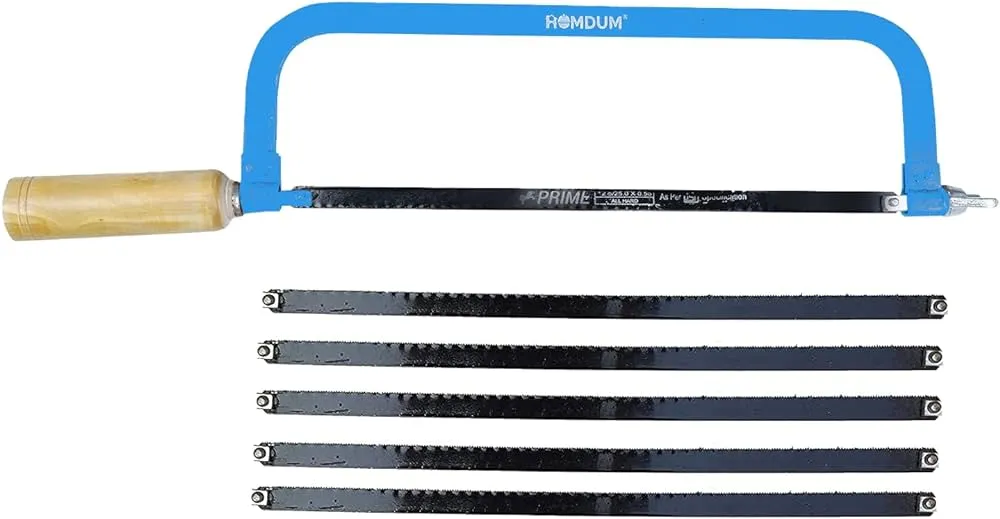
Hachaw is used for cutting metal pieces, like rods, pipes, sheets, etc., in the fitting shop. It consists of two main parts – a toothed blade and a fixed or adjustable frame. According to the design of the frame, the hacksaws are of two types :
1. Fixed frame hacksaw
It consists of a frame of fixed type (not adjustable). The blade of a fixed length is mounted on the frame.
2. Adjustable frame hacksaw
It consists of an adjustable frame. Its length can be increased or decreased according to the length of the blade.
Read More- What is an Automotive Air-Conditioning System?
#4. Scrapers

Scrapers are used to scrap metal surfaces by rubbing. They are particularly used where grinding wheels cannot work. A scraper is just like a file having its edge at one end and a handle at the other end. Scraping is done by hand. The edge of the scraper is slightly rubbed on metal surfaces so that the surface becomes smooth. Scraping is very useful for finishing curved surfaces.
Scrapers are made of old files. The cutting edge is tempered. When it becomes blunt, it can be sharpened on an oil stone. According to the shape, the scrapers are flat, triangular, half-round, and hook-type.
Read More- What are the Uses of Catalytic Converter in a Vehicle?
#5. Scriber

A scriber is a piece of hardened steel rod pointed like a needle on one or both ends. It is held like a pencil to scribe metal lines. Several styles of scribers are available. The bent end is used to scratch lines in places where the straight end cannot reach. Scribers must be kept sharp. If the points become dull, sharpen them on an oilstone.
Read More- Diesel Smoke Problem in India | Read the Full Article.
#6. Try Square
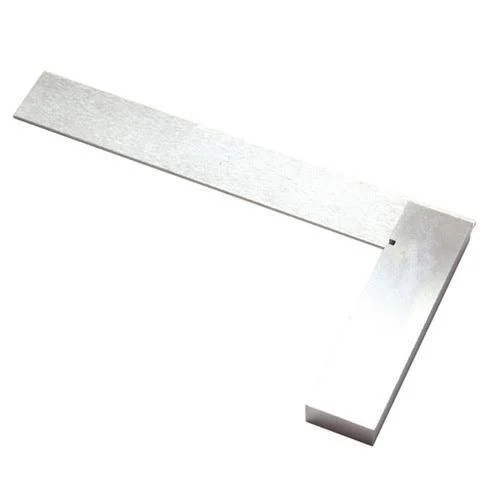
Try square is an important tool and widely used in the lilting shop to check the perpendicular surface and also to check the flatness of the u surface. lt consists of u thick C.l. or M .S. stock connected with a thin M.S. blade or strips exactly at 90°. Their edges are hardened. According to the work, the try squares are made in different sizes.
To check one surface perpendicular to the other of a workpiece, the stock is kept pressed to one surface and the other surface is seen whether it is completely touching with the blade edge. If it is completely touching, the two surfaces of the workpiece are perpendicular to each other. lf the blade edge touches completely the workpiece surface in all directions, the surface is flat.
Read More- What is a Tandem Master Cylinder?
#7. Punch
A punch is a circular rod having one end pointed and the other end flat. Its body is knurled. It is used to mark points on the workpiece for further operations like drilling, filing, culling, and chipping. To mark a point, the punch is kept vertical on the surface touching its pointed end with it.
Its upper end is then slightly struck by a hammer. In one stroke only, the pointed end of the punch gives a sufficient impression of the workpiece in the form of a point. It may be the center of a hole. The drill can be set on it easily to make a hole. Several points can be marked in a line by punch. The points in a line are easily visible when cutting or chipping the workpiece.
Read More- What is the Meaning of CC of an Engine?
#8. Vices

Any job being performed manually requires proper holding. They are normally held by certain devices and one of these is called a vice. Most of the manual operations such as filing, sawing, cutting threads by hand, deburring, and many machine operations such as shaping, milling, etc. are done by clamping the work in the vice since rigidity of the job is necessary while conducting any operation.
Holding the work, either small or large, round or square, becomes very easy when held by the vice. Sometimes, the shearing of thin sheets is also carried out with the help of the vice.
The bench vice is fixed on the bench. The bench titter and machinist uses this vice for holding a variety of manual jobs and assembly and dismantling of machine parts and equipment, etc. There are two types of bench vice which are used in a machine shop.
Read More- What is a Double Wishbone Suspension System?
#9. Hammers

The hammer is man’s primitive tool. In the earliest times, stone was used to tighten a wooden piece and for striking. Even now there is no change in its construction. Instead of a stone head, a metal head is used for striking.
Different types of hammers are-
1. Ball peen-type hammer
This hammer is commonly used by mechanics. The peen (head) is ball-shaped, therefore it is used for fonning a rivet bead by spreading the shank of a rivet. This is a very common type of hammer used for striking while doing general work in the shop or at home.
2. Cross-peen type hammer
The peen of this hammer is flat and forms a cross with the hammer handle. This type of hammer is used widely in sheet metal shops for bending, providing channels in sheets, collars, swaging, etc.
3. Straight peen hammer
The peen of this hammer is flat but straight to the handle. This hammer is widely used in sheet metal shops for ending, providing channels, working on comers, etc.
4. Claw hammer
The hammerhead has a cut in the center and is bent in a sharp curve. This is used for pulling nails out of wood with the help of the head, while the face is the same as that of a ball peen hammer. This is mostly used by cobblers and carpenters. Sometimes, the peen has a small curve on the claw and is called a ripping hammer. This is used for ripping wood.
5. Sledgehammer
This hammer is used by blacksmiths, wood-cutters, stone-breakers, fabrications, etc., for heavy jobs. There are three types of sledge hammers : (a) double-faced ( b) c;oss peen and (c) straight peen.
6. Soft hammer
A soft hammer is made from soft metal such as copper This is used for hammering finished jobs and for aligning jobs on a machine.
7. Soft-faced hammer
This hammer has only soft faces of animal hide, copper, and plastic. etc. The body is generally made of steel. This is used for working with finished jobs, especially in assembly shops, garages, etc. Since the faces are soft they do not leave any mark on the job. They are sometimes called according to the material used for the face.
8. Mallet
A wooden hammer is called a mallet. This is used by carpenters to drive their tools and by sheet metal workers for bending thin sheets.
Read More- 5 Functions of Stabilizer Bar You Should Know.
#10. Pliers

A plier is a hand tool used for holding and gripping small objects at places where the use of hands is unsafe or inconvenient. It is also often used as a wrench to hold and turn, but this is not a safe practice and should be avoided.
Generally, there are two types of pliers in common use: the combination or slip joint plier used for holding and gripping small objects; and the nose plier which has a long tapering nose used for positioning circlips; and removing and placing small objects in narrow spaces.
Read More- What is Camber, Caster, King Pin Inclination, Toe in and Out?
#11. Screwdrivers

The screwdriver is one of the most commonly used tools in the workshop and at home. It is used to loosen and tighten screws which have slots in their heads. A screwdriver is available in several sizes, shapes, or types.
Sizes of the screwdriver
The size of a screwdriver is measured by the length of the shank and is available in a variety of sizes. Sizes of 50 – 500 mm are very common. While selecting a screwdriver. make sure that the point fits in the screw slot.
Types of screwdriver
The commonly used types of screwdrivers are listed below :
- Standard
- Cabinet
- Standard with a square shank
- Flat blade (London pattern)
- Electrician’s screwdriver
- Motor
- Off-set
- Phillips
- Ratchet type screwdriver
- Stubby or close-quarter
- Watchmaker’s screwdriver.
1. Standard Screwdriver
This screwdriver is used for general work. Some screwdrivers or standard makes are equipped with stronger shanks and heavy-duty handles: and are used for heavy-duty work.
2. Standard Screwdriver (with a Square Shank)
The shank of this screwdriver is square. The wrench is sometimes used for turning the shank to get a greater force. Otherwise, this screwdriver has the same parts as a standard screwdriver.
3. Cabinet Screwdriver
This screwdriver is used for driving wood The handle is made flat on two sides to get an extra grip to drive the screw in wood. Carpenters and cabinet makers use such a type of screwdriver.
4. Flat Blade Screwdriver
This screwdriver is also used by cabinet makers and The blade is made from a flat strip to make it stronger. The width of the point in such a blade is more than the length of the screw slot so that a greater driving force while fitting the screws in wood, is achieved.
5. Electrician’s Screwdriver
This screwdriver is like the standard screwdriver but has a long thin shank and is insulated. It is very useful for driving small screws. Some screwdrivers are equipped with a small mechanism for testing live wires. The handle of this screwdriver is generally made of cellulose acetate molds.
6. Motor Screwdriver
This screwdriver has a short shank and is used where there is limited space. The shank is flat throughout.
7. Off-set Screwdriver
An offset screwdriver has a bent shank with points on both ends. It is used for driving screws that cannot be reached with a straight-shank screwdriver. One of the points is forged from an octagonal bar in line with the shank and the other is at 90°, making it easy to drive even where the space is limited.
8. Philips Screwdrivers
The tip of the screwdriver has slots and is cross-shaped. The baled suit’s head of a Philips head screw. This type of screwdriver has a better grip than the standard screwdriver of the same size giving it a better grip and also preventing damage to the head.
Read More- What is Power Steering in a Car? 2 Different Types of Power Steering.
9. Rachet Screwdriver
This type of screwdriver is used for fast motion while driving a screw. The rachet is fitted in the handle. The hand is not lifted for the fresh motion to turn the screw clockwise or anti-clockwise. Some screwdrivers have a worn type shank and they are operated by pushing the handle down.
Such screwdrivers are called quick-motion ratchet screwdrivers. Another common ratchet-type screwdriver is a ratchet-type off-set screwdriver. This type of screwdriver can be adjusted quickly for right and left-hand drives.
10. Stubby Screwdriver
This screwdriver has a very short shank and is used where there is limited space. This is commonly used by electricians and motor mechanics.
11. Watchmakers Screwdrivers
These are small, fully metallic screwdrivers coming in sets of four or six. Some screwdrivers are made with detachable handles which are used for all shanks.
#12. Wrenches
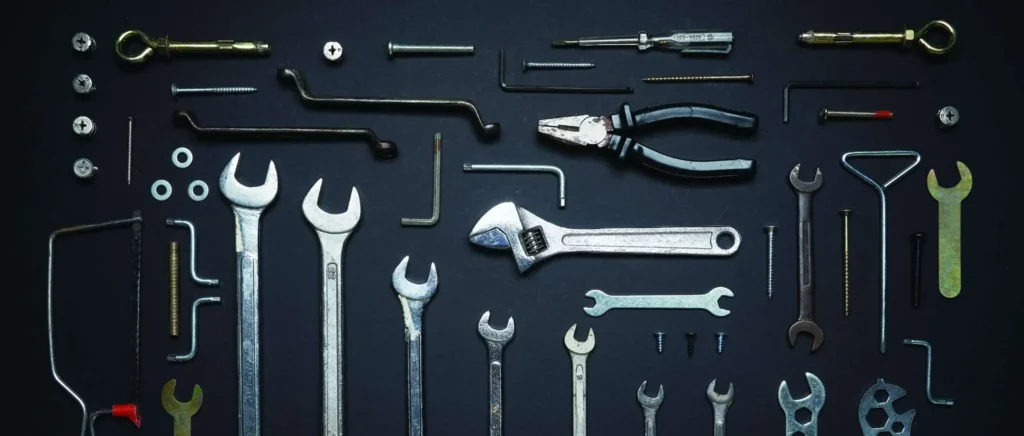
With the greater application of machinery, the variety and sizes of wrenches in daily use have also increased. The traditional open-end wrenches, pipe wrenches, and monkey wrenches have been replaced by those that are generally made of chrome-molybdenum or chrome-vanadium steel.
Types of Wrenches
The different types of wrenches are-
1. Open-end wrench
The head of this wrench comes straight or angular to the center line. The open-end wrench is used where there is sufficient space for driving it. The head of the angular type is angled slightly at 15 or 22°. The nut may be turned a little farther, enabling the workman to get a fresh start on the nut. Another wrench is the ‘S’ wrench which is also useful where there is little space while working.
2. Socket wrench
These wrenches have detachable pa.-. ts such as the head, the shaft, and the driving lever (handle). This is very useful where it is difficult to work with open-end wrenches. Some wrenches have handles fitted with a ratchet which enables the worker to drive the shaft quickly and save time as it is not necessary to remove the head of the wrench from the nut. This wrench is widely used in automobile shops, repair shops, and assembly shops.
3. Pipe wrench
This wrench is used for turning pipes, pipe fittings, and round bars. It is very useful and used by plumbers and millwrights. The jaws have serrations to keep the work in grip.
4. Monkeywrench
The jaws in this type of wrench open parallel, with the help of a screv•. thus providing suitable gaps for all sizes of nut. The jaws being flat do not spoil the sides of the nut. This is not very different from pipe wrenches and is a general-purpose tool.
5. Adjustable wrench
The main advantage of this wrench over an open-end wrench is that th jaws can be opened within limit according to the size of the wrench. The jaws are adjustable and fit the cavity to the shapes of the open-end wrench.
This differs from a monkey wrench in that the opening of this wrench is not as much as that of a monkey wrench, but has a stronger grip. In the absence of open-end wrenches, this wrench works as a substitute. However, where possible, use a fixed wrench as it gives a better grip than an adjustable wrench.
6. Close-end wrench
This is similar to the single end wrench but it encloses the nut entirely. It is called a box wrench.
8. Twelve-point box wrench
The wrench head has twelve notches in the hole. The point of the nut may be gripped by six notches in the case of a hexagonal nut and four notches in the case of a square nut. This allows the turning of the nut where very little turn is possible. It is also known as a ring spanner.
9. Tea-socket wrench
This is made in the shape of the letter ‘T’. The hole suitable to the nut is made in the head. The wrench is suitable for applying great force. It is used at odd places where open-end and close-end wrenches do not work, such as the opening of the cylinder heads of engines, etc.
This wrench is similar to a socket wrench. The difference lies in the construction. While this wrench is made from one piece of metal and the head is welded to the shank, the handle of the socket wrench is detachable.
Read More- Read About the 4 Different Types of Wheels in the World.
10. Off-set socket wrench
This is just like the ‘T’ socket wrench but is used for light-duty work and when the job is within easy reach. This is good for nuts which require very little leverage.
11. Allen wrench
This is made from a hexagonal bar and is bent to drive a socket or an Allen head screw.
12. Torque wrench
The wrench is used when it is necessary to know the amount of force to be applied to the nut or the bolt. The amount of force is generally indicated on the dial or scale which is mounted on the handle.
Some wrenches of this type have an indicator that gives a signal when the pre-set force is reached. Other wrenches have ratchets or handles that slip off when the force designed is achieved. These types of wrenches are a boon to the industry where the parts assembled require a definite force.
#13. Taps

Taps are used for cutting internal threads. The process of cutting internal threads by the tap is called tapping. The tapping may be done either by hand or by machine. A tap may be compared with a bolt having teeth formed on it by cutting flutes parallel to its axis. The flutes act as channels to carry away the chips formed by the cutting action. It is made of hardened carbon steel or alloy steel.
Taps are of many types, like hand taps, machine taps, straight shank taps and bent shank taps, regular pipe taps and interrupted threads pipe taps, solid taps, and collapsible taps. Many other taps are available and are usually named according to the kind of thread they are to cut.
The hand taps are furnished in three sets-taper, plug, and bottoming. These three taps are identical in size, length, and vital measurements but differ in chamfer at the bottom end. The taper tap has about 10 threads chamfered at the end, the plug tap about 5, and the bottoming tap only 1.
The taper tap should be used in starting the thread because it ensures a straighter starting and more gradual cutting action on the threads. If it is a through hole, no other tap is needed. For closed or blind holes where it is desired to have threads to the very bottom, the taper, plug and bottoming taps should be used in order named.
The plug tap is generally used where threads are to be made by using only one tap. The bottoming tap is best suited when threads are to be cut in a blind hole. Serial hand taps are also available and are similar to the above set except that each cuts only a certain percentage of the complete thread.
They are numbered 1, 2, and 3 and are used in the same order. These taps are mainly used in cutting tough metals because the load is shared by the three taps, making cutting easier and producing a smoother thread.
Before tapping, a tap-size hole is drilled, which provides the necessary metal for the threads. If an M 10 thread hole is to be cut, the tap size drill is 9 mm in diameter. This is equivalent to the root diameter of a M 10 standard screw and allows sufficient metal in the hole for the threads.
Read More- What is the Slip Joint in the Propeller Shaft in the Transmission System
#14. Dies

Dies are used to cut external threads on the rod or pipe ends. Dies are made of high-carbon steel or high-speed steel and are hardened and tempered. The process of cutting external threads by the die is called dyeing. When dyeing is done by hand, the die is held in a die stock which provides the necessary leverage to turn the die in cutting.
The dies may be square, round, solid, split, or prismate type. A die simply consists of four portions projecting radially towards the center, on which the threads are cut. At least two threads on the sides of a die are tapered. Dies are mainly used to cut threads on pipe ends or to repair worn treads. Dies are not suited for production work.
For the successful operation of taps and dies. the nature of the material to be threaded must be considered. since no tool can be made to work successfully for all the materials. Proper lubrication during the cutting operation ensures longer life of the taps and dies; and results in smoother threads.
Both the tapping and dying may also be done by machine. The tap or die is held in a special bolder so that it can be withdrawn from the work without injury to the threads. This is obtained by reversing the rotation of the tool or work after the cut has been made. Although much tapping is done on drill presses equipped with some form of tapping attachment, however. most production tapping is done on specially designed machines. Such machines are automatic in operation.
Read More- What is a Fluid Drive or Liquid Coupling in Automobiles?
#15. Cleaning Brush

Wire brushes are used for cleaning rough surfaces whereas soft bristle brushes are meant for cleaning parts being washed in solvent. Power-driven rotary wire brushes are used to remove carbon from combustion chambers. etc. Scrapers are used to scrape gaskets or other such materials from flat or irregular surfaces.
#16. Tools for Tubes
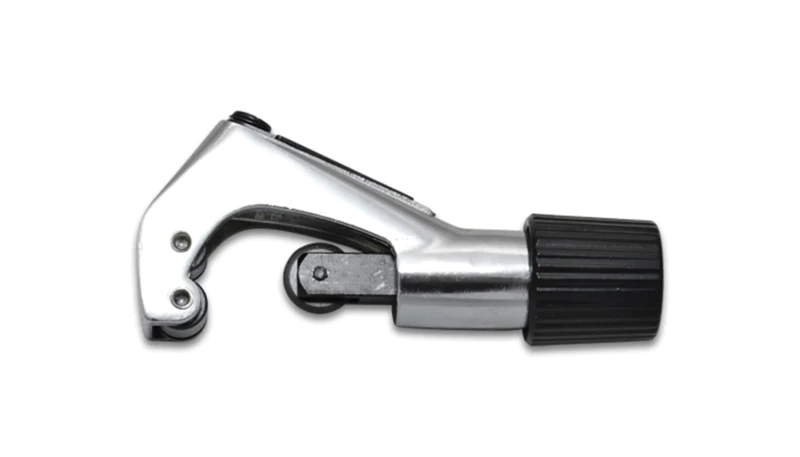
A tube cutter is used for cutting tubes. A hacksaw should not be used for this purpose because it cannot cut squarely and leaves rough edges. Cut tube ends are reamed to remove any burrs from the inside to make a good flare. For the flaring of the tube ends, a special flaring tool is used.
Read More- What is the Function of Regenerative Braking?
#17. Tools for Tires
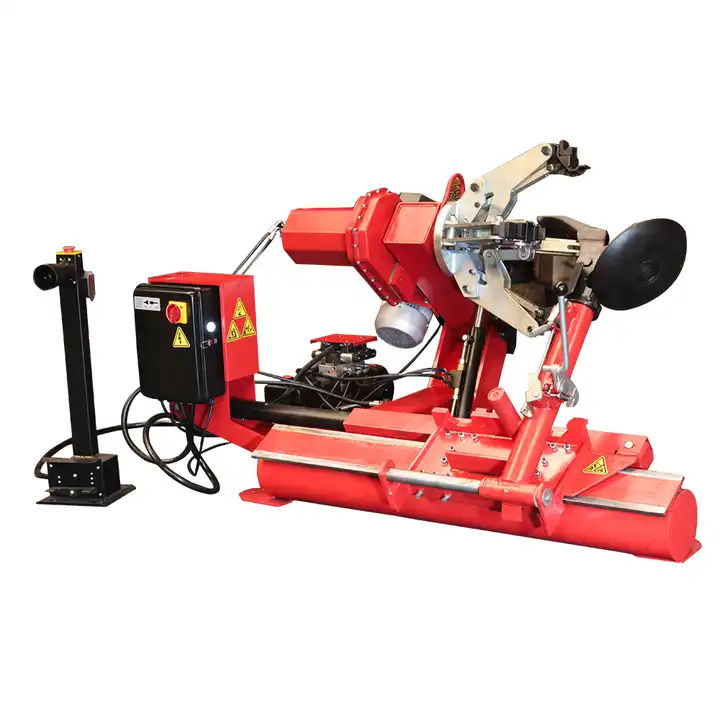
The tools required for the tires are tire levers, a vulcanizing machine, a tire pressure gauge, and an air compressor. Tyre levers are required for removing the tires from the wheel rims and then re-installing back. The vulcanizing machine is meant to repair punctured tubes.
As it is very important to maintain specified air pressure in the tires, a tire pressure gauge is a must to check the same. A Tyre foot pump is a valuable accessory to be kept in the car itself for inflation in emergencies. Even in the garage, a foot pump is essential if there is an air compressor.
Tire Remover
Hydraulic tire removers for cars, trucks, buses, etc. are available. These can be either floor mounted for permanent fixing in a workshop or are available as portable models also for roadside tire and wheel service. The ram unit is hydraulically operated using a handle and uses SAE 10 oil.
#18. Feeler and Wire Gauges

The feeler gauge comprises several leaves in each leaf has a different thickness. The length and width of the leaves are equal. The name feeler gauge comes from the fact that they are used to check such small gaps that can just be felt.
They are used to check and adjust the gaps of spark plug electrodes, contact breaker points, air gap points in distributor rotor assembly, valve tapped clearance, etc. Depending upon the type of services performed by them, the feller gauges may be classified as follows-
- Universal master gauge containing 25 leave
- Standard feeler gauge containing I0 leave
- Go and No Go type feeler gauge containing 15 step-ground leaves.
- Overhead valve feeler gauge containing 16 offset blade
- lignite ion feeler gauge containing 12 leave
- Piston gauges containing 8
- Spark plug wire gauge containing one electrode bender and 8 wire
All these types are mounted on a handle through a pivot and can be pulled out readily for use. Different types of feeler gauge (a) universal master gauge, (b) standard feeler gauge, and (c) Ignition and wire gauge (Courtesy: OTC, USA].
Read More- How Does A 3-Speed Gearbox Work and Kill Power in a Vehicle?
#19. Vernier Caliper
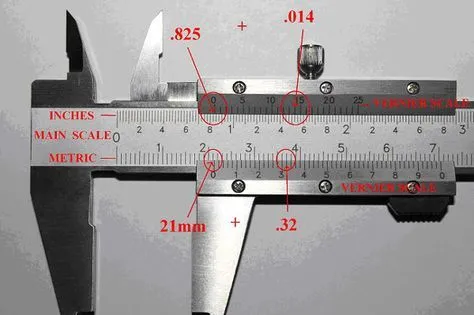
It is used for taking both inside and outside measurements to l/l 000″ (0.00 l “). It uses the vernier principle of measuring which was named for its inventor Pierre Vernier (1588-1637), a French mathematician. The verniers are available in standard sizes 6″, 12″, 24″, 36″, and 48″ length. The 6″, and 12”, sizes are most commonly used.
A vernier caliper consists of a graduated vernier slide assembly, screws, and adjusting nut. The slide assembly moves as a unit along the beam. The beam is graduated on both sides. When the jaws are closed together the, “()” on the beam will be aligned with the “O” on the vernier plate, if there is no error.
How to Use the Vernier Caliper?
To measure the outside diameter of a rod, bring the rod between the jaws. Slide the assembly until the jaws contact the rod slightly. Lock the clamping screw and make the final adjustment with the fine-adjusting nut. The jaws must engage the rod not firmly but rigidly. Lock the assembly unit to the beam, remove it from the rod carefully, and read the vernier caliper.
#20. Power Tools

Power tools are increasingly used in modem automated auto workshops. They are operated by pneumatic, electric, or hydraulic powers. Their use envisages quicker, effortless, and efficient service. Although a large number of power tools are in use, however, only the main among them will be described briefly as follows.
Pneumatic Nut and Bolt Tightener
It tightens and loosens the nuts and bolts in a short time. This is a portable machine whose working end can be changed to suit different sizes of bolts and nuts.
Valve Refacer
It is used to recondition the worn and worn valve faces. On employing an attachment, it can be used to grind the valve stem, tappet, and the rocker’s arm. The electrical-powered valve master refacer model SD 0150, has the following specifications.
- Valve head capacity = 102 mm
- Valve stem capacity = 17.46 mm
- Power input = 600 watts
- Weight = 350 kg
Portable Drilling Machine
This is an electrically powered machine which is used to make holes wherever required. It can be taken conveniently to any area of repair since it is handy, compact, and portable.
- Chuck size = 6 mm
- Power input = 500 watt
- No load speed = 2800 rpm
- Weight = 10 kg
Drill Stand
lt is used to mount the drill machine. The job to be drilled can be placed and clamped on its base. The height of the drill machine can be adjusted suitably to accommodate jobs of different heights. For this purpose, the grooves are cut on its vertical stand. The height adjustment is done using a lever and mechanical linkage.
Polisher and Sander
This is an electrically powered machine used to rub the burrs from the surfaces of components, and then polish them to super finishing accuracy. The sanding is accomplished employing emery paper or emery cloth of coarse grade while the fine grade is used for polishing.
- Paper size = 1 15 x 280 mm
- Power input = 475 watt
- Orbits = 5000 rpm
- Weight = 20 kg
Conclusion on Garage Tools and Equipment
Setting up a well-equipped garage with the right tools and equipment is essential for various automotive, woodworking, or DIY projects. Ensure that you invest in quality tools and equipment for durability and safety. Additionally, consider your specific needs and the type of projects you’ll be working on when selecting tools for your garage.
Frequently Asked Questions(FAQ’S)
How can I determine the quality of tools before purchasing them?
Look for reputable brands with a history of producing reliable tools. Read reviews from other users, check for warranty information, and examine the build quality and materials used in the tools.
Can I save money by opting for cheaper tools instead of investing in quality ones?
While cheaper tools may seem like a cost-saving option initially, they often lack durability and may require frequent replacement. Investing in quality tools upfront is a more economical choice in the long run, considering their longevity and performance.
How often should I assess and update my tool collection in the garage?
Regularly assess your tool collection based on the evolving needs of your projects. Replace worn-out or damaged tools promptly, and consider adding new tools that can enhance efficiency and safety in your workspace.
